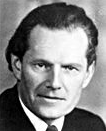 |
|||||||||||||||||||||||||||
|
|
|||||||||||||||||||||||||||
|
|
|
|
|
|
|
||||||||||||||||||||||||||||
€žEin Gerechter unter den VoelkernHans Calmeyer in seiner Zeit (1903 - 1972)€žIn the time from 1934 to May 9, 1945, there reigned the barbaric and senseless thought that a Human Life had no value if it so pleased the Fueher to so declare. After that date, the concept of eradication of human life as equivalent to pests was gone in a flash. In 1963, Hans Calmeyer testified before authorities in the Netherlands: At the beginning of March 1941, a lawyer named Hans Calmeyer is hired by the Reichskommissariat in Den Haag as an assistant researcher in the department of internal administration. Since the 10th of January 1941, Jews in the Netherlands are forced to register, without really perceiving what this registration will later mean for them. Calmeyer is an administrative legal analyst. This “small wheel” in the works of the administrative machinery soon begins to not quite turn in the way it was designed: regulations and demands of the Dutch population are softened or weakened. The tactically talented Calmeyer even succeeds in delaying and derailing orders for repression. One day, his department is entrusted with the task of deciding cases of doubt about the registration-requirements of specific Jews and mixed Jews. Calmeyer becomes manager. At this time, the degree of Jewishness can determine results of freedom, pursuit, or murder by the authorities. Calmeyer sees his opportunity: it is suggested that documents have been lost in another racial classification process. Even verbal testimonies are accepted. Lawyer Calmeyer makes clear that he is ready to recognize all possible signs of prior Aryan ancestry, no matter how thin the evidence. In order to satisfy the otherwise so thorough German administartive machinery, Calmeyer’s team accepts evidence of all sorts, with any genuine appearance. Overnight, a whole line of ancestors of Calmeyer-Jews are declared to have switched to Christianity in the 19th century. Their descendants as a result no longer qualify as Jewish under the racial laws of Nurnberg. A multitude of applicants can thus immediately be absolved by these documents. He also succeeds in delaying an array of ambiguous cases in order to win time against the collective racial furor. Calmeyers activity is not safe for long. It becomes evident to higher officers that particularly under Calmeyer, increasingly numerous Jews are no longer coming under the racial laws. In internal writings and internal conversations, he begins to be called Protector of all Jews and even Saboteur of Jewish laws. The Gestapo demands to take over the handling of all Jewish ancestry cases. Calmeyer however remains undeterred: he continues as before, even though he is drawn into the crosshairs of the pursuit- and destruction-apparatus. But Calmeyer falls into a mortal dilemma: if he endows all applicants with Aryan parents and ancestors, his forgery operation will be ended. He must in any case deal with the Nazi justice ministry under circumstances which demand that he properly identifies Jews from time to time. This weights on his conscience in a way that will pursue him his entire life. The tactical expert has to load shared guilt for a few onto himself, in order to save the many. Calmeyer’s family documentation saved 2866 Jews whose names are able to be determined from deportation into the concentration and death camps. If one considers the families that belonged to these individuals who were also able to escape [and others that his group warned before they could be picked up for questioning], then the number of saved people could be as many as 17,000. The story of Calmeyer remains a largely unknown chapter in the chronicle of saved Jews in World War II. After the end of the war, Calmeyer tries again to establish himself in Osnabrück. He becomes lawyer again, and notary. At the same time, he develops a lively life within the cultural milieu of the city. In humility he is silent about his own deeds, in fact blames himself to have done too little. In the early 60’s, Journalists come upon his fate. There are radio and television reports, which however have nowhere near the knowledge of the situation. In the 60’s, no one in the German Wirtschaftswunder wants to hear of the Nazi past. Even as late as 1965, he writes his letter (to Jacob Presser) of his exasperation and desperation. He withdraws from society and begins to intensively deal with the world of the soul, in literature and mystical sources. His last years are increasingly dominated by depression and esoteric escapist themes. [He lives the life of an ascetic, sleeping in a room barely containing a cot and washbasin]. He dies in 1972. Only later is he re-discovered for his deeds. In 1988, his story begins to be researched. In 1992 he is honored by Yad Vashem as “Righteous among Gentiles.” In 1995, he is posthumously awarded with his city’s highest honor, the Moesermedallion. Joachim Castan |
 |
||||||||||
|
|
||||||||||


